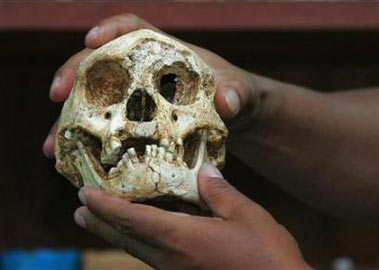
A scientist holds the skull of the remains of
one of Indonesia's hobbit-sized humans in Jakarta on November 1, 2004.
Hobbit-sized humans who survived on an isolated Indonesian island until
12,000 years ago were smart enough to make stone tools even though they
had small brains, scientists said on Wednesday.[Reuters]
|
Hobbit-sized humans who survived on an isolated Indonesian island until
12,000 years ago were smart enough to make stone tools even though they had
small brains, scientists said on Wednesday.
Some researchers doubt that tools found with the remains of the species named
Homo floresiensis in a cave on the island of Flores could have been made by the
3 foot tall creatures whose brains were about the size of a grapefruit.
They believe the tools must have been made by modern humans.
Experts have also argued that the 'hobbit' people were modern humans
suffering from an illness that caused their small brain and size.
But an international team of scientists said older tools dating back more
than 800,000 years also found on the island showed the 'hobbits' probably
inherited their tool-making skills from their ancestors.
"Small-brained or not, Homo floresiensis was capable of making stone tools
and therefore the standard story of the relationship between brain size and
behavioral complexity in human evolution may be less straightforward than
currently assumed," said Adam Brumm, of the Australian National University in
Canberra, who headed the team.
Until now it was thought that the larger the brain, the smarter the hominid.
Brumm said his findings suggest that may not be the case.
"The causal relationship between brain size and the complexity of tool
behavior in humans is assumed, not demonstrated," said Brumm.
"Until now stone tools have only been found in association with large and
relatively large-brained hominids, but Homo floresiensis changes that, forcing
us to re-think the way we associate big brain with sophisticated behavior," he
added.
Brumm and his team, who reported the findings in the journal Nature, believe
the tools found with the species dubbed "Flores man" were the end-point in a
tradition of tool-making on the island east of Java which was also home to
Komodo dragons, miniature elephants and other exotic species.
The researchers said their findings show the same types of stone tools found
with the species were made by their ancestors when they arrived on the island at
least 840,000 years ago.
Remains of the new species were found a few years ago when scientists
discovered a partial skeleton of an adult female. The tiny creatures are thought
to have descended from Homo erectus, which had a large brain, was full-sized and
spread from Africa to Asia about 2 million years ago.
Scientists believe they become so small because of environmental conditions
such as food shortages and a lack of predators.